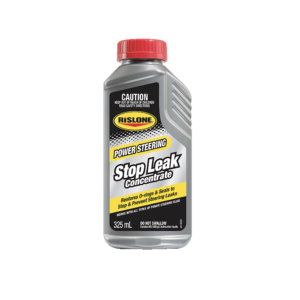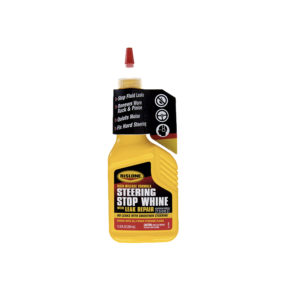- Restores Performance
- Reduces Noise & Smoothes Out Hard Steering
- Stops Leaks and Reconditions Rack & Pinion
- Adds Protection
Product Details
Your car has been with you a long time. As vehicles age and gain more miles, however, the power steering fluid loses its strength and can’t do its job alone. This is when Rislone Power Steering Repair can help.
Internally, pumps whine, gears have play (slack) in them, valves stick, seals leak and the fluid quickly breaks down. Once installed, this powerful solution helps to stop and prevent these problems and enhances the useful life of your power steering system, and in turn extends the life of your car.
- Part Number: 44650
- Dosage: One bottle treats 2 to 3 litres of power steering fluid.
- Size: 500mL
Additional Information
Rislone High Mileage “Kilometre” Power Steering Repair is a unique dual cavity bottle containing a combination of the best performance additives to repair the most common power steering fluid related problems. For many vehicles, this is your last chance before paying an expensive repair bill or replacing the vehicle. Power Steering Repair can be used to top-off the existing fluid when low, or add a bottle when changing fluid. Works on all vehicles, domestic and import. Compatible with ALL types of power steering fluid or ATF, including petroleum, mineral oil and synthetic formulas. Use one bottle to top off or restore fluid level.
World’s Most Trusted Repair Brand Since 1921
Dual Action Formula—Twice the performance
Safe And Easy To Use
Works To Seal & Stop Leaks Plus…
Restores Performance—Reduces noise and smoothes out hard steering.
- Hi-Tech Additives
- Viscosity Improvers
- Friction Modifiers
Adds Protection—Stops leaks and reconditions rack & pinion.
- Fluid Stabilizer
- Lubrication Additives
- Seal Conditioners
The common element between all of the power steering components is the fluid. The fluid touches everything inside the pump, gearbox and rack & pinion. This fluid must lubricate, cool, clean and pressurize for the system to function. In newer systems, the power steering fluid can easily perform these functions. As the vehicle ages and gains more miles, the fluid alone can’t do the job. Internally, pumps whine, gears have play in them, valves stick, seals leak and the fluid quickly breaks down. When installed, Rislone High Mileage Power Steering Repair helps to stop and prevent these problems and enhances the useful life of your power steering system. The result is smoother steering with no leaks.
INSTRUCTIONS:
Adding to existing Power Steering Fluid
Using to seal leaks—Remove power steering dipstick and check reservoir fluid level. On most vehicles, the reservoir is on or near the belt driven power steering pump. Consult owners’ manual for location if needed. If fluid is low, pour equal amounts from the two chambers into reservoir. At least half of bottle should be used. Do not overfill . Check fluid level again. Top off with manufacturer’s recommended power steering fluid as needed.
Replace dipstick and drive 5 to 10 minutes to circulate fluid.
To control slack, reduce noise & squeals, and smooth out hard & tight steering (morning sickness), the entire bottle should be used. TIP: If necessary to prevent overfilling, drain or siphon some power steering fluid from reservoir before using.
Depending on the power steering problem, results will either be immediate or noticeable within (2) days or 150 km of driving. In seriously damaged power steering systems, a second treatment may be required. In this case, it is suggested that the power steering fluid be changed and a second application of Power Steering Repair be added.
Changing Fluid
If using Power Steering Repair when changing power steering fluid, add entire contents of bottle. Then top off with manufacture’s recommended fluid to proper level. Drive vehicle and recheck fluid level.
DOSAGE:
One bottle is designed to treat 1 to 2.5 litres of fluid capacity, which is the normal size for most vehicles. For smaller systems from 0.4 to 0.9 litres, only use half bottle, pouring equal amounts from each side. For larger systems use one bottle for every 2 litres of capacity.
What Is Your Power Steering Problem?
Small Leaks—Need to add fluid 1X per month
Medium Leaks—Need to add fluid 1X per week Leaks—Pump, Gearbox and Rack & Pinion
Noise—Whining, Squeals and Growling
Slack or Loose Steering
Morning Sickness—Hard or tight steering when cold
Worn Parts—Renews worn rack & pinion
WE CAN HELP!!!
Safe For— Domestic / Import, Cars, Ute’s, Trucks, SUV’s
Fluid—Regular Petroleum, Mineral Oil and Synthetic Power Steering Fluids
WHAT IS A POWER STEERING SYSTEM?
There Are Two Basic Types of Power Steering Systems
Gearbox (Re-circulating-Ball)
Most Rear-Wheel & 4-Wheel Drive — The gearbox contains a grooved metal shaft called a worm gear. This gear is threaded into a metal block with ball bearings between the threads to reduce friction. The block turns a pitman arm which is connected by the rods to each front wheel.
Rack & Pinion — Most Front-Wheel & All-Wheel Drive. The steering shaft connects to a pinion gear inside the metal housing. This pinion gear has teeth on it that mesh with the teeth on the rack. This rack is connected to each front wheel with the rod ends.
Steering Components
Power steering systems are combination of mechanical, hydraulic and some electrical parts.
Mechanical
Many mechanical parts are required to operate a power steering system. Some of the more important parts are steering shaft, rack & pinion or gearbox and fluid pump.
Hydraulic
The hydraulic system uses a belt-driven fluid pump to create pressure and send this fluid through a high pressure hose to either the rack & pinion or gearbox.
Electrical
Some later model vehicles use electronic sensors to detect the power steering fluid pressure and send information to the vehicle computer.



